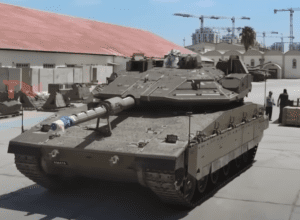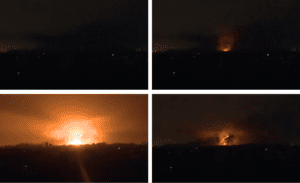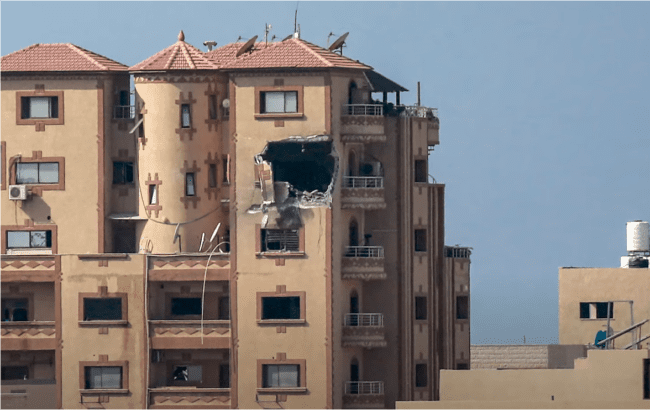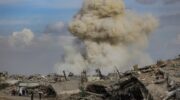Israel denied the attack, but a four-month investigation shows the Agence France-Presse office came under direct tank fire.
by Hoda Asman and Farrah Jalad, reposted from The Intercept, June 25, 2024
This investigation, conducted by Arab Reporters for Investigative Journalism, is part of the Gaza Project, a collaboration involving 50 journalists from 13 organizations coordinated by Forbidden Stories.
“Targeting of Al Ghefari tower, which houses media offices, west of Gaza City,” read the chyron of Alhurra TV, a U.S. government Arabic broadcaster, just before 11:57 a.m. local time on November 2. The channel was covering the strike on an 18-story building, the tallest in the Gaza Strip. The building is visible in the far left corner of the screen when suddenly an explosion rattles the image. Debris and smoke fly live on camera. The presenter, unsure of what had happened, says, “We don’t know yet where this strike is, but it happened live just now.”
What the presenter didn’t know was that viewers were watching live on TV a strike on another media organization, Agence France-Presse, less than an hour after the one on the offices of Palestine Media Group in the al-Ghefari tower — the very building Alhurra TV was discussing while viewing the AFP live feed. AFP itself occupies the 10th and 11th floors of the 12-story Haji Tower, just a few hundred meters, or 0.2 miles, away on the same street.
Alhurra broadcast the strike live not because it had its own camera in the tower, but because the network was tapped into an AFP live feed from a camera set up on the balcony of the 10th floor. The attack caused extensive damage to the building and offices: a large hole in one side of the building, and significant interior destruction. Fortunately, no one was there. AFP’s Gaza City staff of eight had evacuated the building, leaving behind a mostly unmanned camera powered by solar panels, broadcasting a 24/7 live feed. AFP was the only one of the three major global news agencies still broadcasting live from the Gaza Strip.
AFP immediately contacted the Israeli military. The initial response was that there were no strikes on the building. Pressed for more details, the Israeli spokesperson said the army had carried out a strike nearby that “might have caused debris” but that “the building was not targeted in any way.” AFP said the extent of the damage cannot be explained by the military’s response and requested “an in-depth and transparent investigation.”
The condemnations were swift. AFP’s chair and chief executive Fabrice Fries said the bureau’s location was known and communicated to the Israeli military routinely “precisely to prevent such an attack and to allow us to continue to provide images on the ground.” The Committee to Protect Journalists, or CPJ, issued a statement categorizing it as an “attack.” The International Federation of Journalists demanded “an immediate investigation.”
After the early November strike, the war in Gaza grew more intense and the number of Palestinians killed, reported to be over 37,000 today, continued to climb. The scale of the destruction was beyond anyone’s expectations.
The AFP incident was mostly laid to rest until Arab Reporters for Investigative Journalism and its partners, including AFP, began looking into it as part of the Gaza Project: a collaboration of 50 journalists from 13 media organizations coordinated by Forbidden Stories to investigate attacks on journalists and press infrastructure in Gaza and the West Bank.

The four-month investigation revealed that, contrary to Israeli army claims, the AFP office was directly fired at by Israeli tanks. The tanks fired four times between 11:55 a.m. and 12:09 p.m. local time on November 2, from around 3 kilometers away.
At least two strikes hit the AFP offices, damaging it and making it unusable.
The investigation’s findings relied on independent visual analyses of the live feed footage conducted by Le Monde and Paper Trail Media. They were confirmed by weapons and other experts. The findings matched the conclusions from an audio analysis provided by Earshot, an organization specializing in forensic audio investigations.
Adrian Wilkinson, a forensic explosives engineer who regularly works for the United Nations, said, “It is almost certain that the AFP office was shot at by an Israeli tank.” At least five other experts, including independent weapons and conflicts researcher War Noir and Trevor Ball, a former U.S. Army explosive ordnance disposal technician, agreed. Ball said the damage to the server room was consistent with tank fire.
Wilkinson ruled out the possibility of an accidental hit. He’s convinced that the soldiers operating the Israeli tanks intended to hit that floor precisely. “The weapon type and accuracy inherent in the Israeli tank weapon system means that the weapon hit the target it was aimed at,” he said. “The question of why remains unanswered.”
A key element in the investigation was a series of flashes of light appearing 4 seconds before every explosion in the live footage. The flashes are shots being fired. A calculation based on an analysis of the flashes and detonations concluded that they were fired from about 3 kilometers away. Further analysis of the speed and features of ammunition led to the conclusion that it was a tank that fired them. Only Israel has tanks in Gaza.
Footage from al-Ghefari tower, the first building hit that day, shows Israeli tanks near the area on November 1. Satellite imagery from Planet Labs on October 31 and November 3 show hundreds of tanks a few hundred meters north of the suspected firing area, with visible tank tracks in the area. Satellite imagery shows no tanks the days before.
On November 2, 2023, Israel announced the completion of its encirclement of Gaza City, marking the beginning of the city’s siege.
In a written response to the consortium, the Israeli military insisted that there was no strike on the building on November 2 and said the AFP office was not targeted.
AFP Notified Military:
AFP thought it had taken all necessary precautions to secure its offices when the war started. The news agency had had an office in Gaza for 30 years and were familiar with the protocols. AFP routinely shared its office address and Google Maps coordinates with the Israeli military, a standard practice for foreign media in Palestine. In October alone, AFP representatives reminded the military four times of its office location at Haji Tower in Gaza City.
On October 9, 2023, the news agency sent a letter from its CEO urging the military to “exercise extreme vigilance regarding the security of our Gaza staff,” particularly following an incident where a piece of shell landed on their building’s terrace. That same night, the Foreign Press Association asked for the AFP’s office location to share with the Israeli military, as it was doing for member organizations. The association confirmed to AFP that they shared the information with the army.
Despite their efforts, in the early hours of October 10, a staffer from the Gaza office informed Marc Jourdier, the agency’s Jerusalem bureau chief, of a call to a local resident by the Israeli military to evacuate the building. “Don’t waste a minute and evacuate,” Jourdier told the staffer. “I’m calling the army and getting back to you ASAP.”
Jourdier contacted the military and sent the office’s coordinates again. At 2:26 a.m., a powerful strike hit a smaller building nearby. Several people were killed, including three journalists who were standing in front of the building to cover the expected strike on Haji, which by then had been evacuated. An Israeli spokesperson told Jourdier they managed to stop the strike “thanks to your call.”
The full picture of what happened that night is still unclear. In its response to the consortium, Israel’s military said it targeted a facility used by a Hamas member but did not explain why an evacuation call was issued for the building housing the AFP.
On October 28, five days before the attack on the AFP offices, Jourdier sent the office location once more.

“Importance of the Livestreams”:
Presented with the investigation’s findings, Irene Khan, the United Nations special rapporteur on freedom of opinion and expression, said, “According to international humanitarian law, media infrastructure is civilian infrastructure, so targeting it would be potentially a war crime.”
“I am not surprised,” said Shuruq As’ad, a journalist and spokesperson for the Palestinian Journalists Syndicate. But she is angry. “This is a clear and direct attack on a press office.” She added, “Israel knows the importance of the livestreams, especially the wires and how important they are for the international press which use these wire services.” The syndicate has documented the partial or total destruction of 73 media offices since October.
AFP global news director Phil Chetwynd said Israel needs to explain what their policy around live feeds is and if “in any way” they consider them legitimate targets, “because there’s enough circumstantial evidence to make us suspect that is how they are working.” He added, “We really must have answers and for the moment, we don’t have those.”
The “IDF has a history of attacks on media facilities,” says Carlos Martínez de la Serna, program director at CPJ. He pointed to previous incidents, including the destruction of at least 20 media outlets in 2021, including the building housing The Associated Press and Al Jazeera. He insisted that it is part of a pattern that reflects a “lack of accountability” when it comes to the Israeli military attacking media facilities. “It’s not like you can easily make a mistake,” he said. “Israel knows everything about Gaza.”
51 Minutes Earlier…
While reviewing the AFP live feed for this investigation, Arab Reporters for Investigative Journalism and its partners discovered footage of the earlier strike on the Palestine Media Group, or PMG, offices in the al-Ghefari building 51 minutes before the first strike hit AFP. We showed it to Earshot. “This strike also contains a similar succession of events as the four strikes on the server room: a distant muzzle flash in the same area as the flash observed in the four strikes,” Earshot analysts concluded.
There are notable similarities and differences between the PMG and AFP strikes. The offices of both media organizations, only a few hundred meters apart, were fired at by Israeli tanks on the same day, within an hour of each other. Both had cameras broadcasting live video of Gaza.
While there was nobody in the AFP office at the time of the strike, four people, including two journalists, who later recounted the incident to ARIJ and its partners, were on the 16th floor of al-Ghefari building. One of them sustained a leg injury.
On the morning of November 2, Ismail Abu Hatab, a freelance journalist who had been spending the night in the PMG offices, made his coffee and turned on the computer to finish uploading his footage from the previous night. “I grabbed the camera and then I didn’t see anything, I couldn’t hear anything, all I remember is a yellow line of light,” he said. A wall collapsed on Abu Hatab, and the force of the blast threw Abed Shanaa, the other journalist there that day, against the opposite wall.
Abu Hatab lost consciousness briefly. Then he realized what had happened. “They targeted us directly. They targeted the floor we were on,” he said. Shanaa rushed to pull Abu Hatab from under the rubble, fearing there might be another strike. Shanaa’s 20-year-old son, Haitham, pulled Abu Hatab from under the rubble. There was no elevator because the building had lost power earlier, so Haitham carried Abu Hatab down the 16 flights of stairs.
PMG occupied all four apartments on that floor, giving it 360-degree panoramic views of Gaza. “From the place where I take pictures, I took in all of Gaza,” said Abu Hatab. PMG set up cameras on all four sides and offered live feed services, including to Reuters and Al Arabiya TV.
Hassan al Madhoun, the CEO of PMG, said that a few days before the attack, on October 30, Israeli tanks appeared through the northern windows. Shanaa confirms they were visible from at least two cameras. Footage broadcast from al-Ghefari the day before the strike showed Israeli tanks in the vicinity. The video establishes a line of sight between the building and the area designated through audio and visual analysis as the place where the tanks fired from. Satellite imagery shows tracks from tanks were visible the next day, where none appeared before.
In a written response to the consortium, the Israeli military said it was not aware of a strike in the location and on the date provided.
After evacuating the building, Shanaa took Abu Hatab to the hospital for medical attention. Shaken by what had just happened, Shanaa decided to head to southern Gaza that day. The following day, al Madhoun, who was not at the office at the time of the attack, returned to salvage whatever equipment he could. He took a video of the damage.
Some time between November 25 and December 3, al-Ghefari building was struck again, this time causing more serious damage to the whole structure, with parts of the upper three floors completely collapsing.
While both AFP and PMG experienced similar attacks that day, one notable difference between the media organization stands out: PMG is a local Palestinian outlet, while AFP is an international French organization. Though the journalist was injured in the PMG attack, it was the strike against AFP’s empty office that attracted international attention and merited a response from the Israelis.
Martínez de la Serna, of CPJ, considers this another pattern. “Investigations or responses to the killing of a journalist usually only occur when an international journalist or news organization is affected,” he said. “For local journalists, the typical response is propaganda and nothing more.”
As’ad, of Palestinian Journalists Syndicate, expressed frustration at the international community’s failure to give equal importance to the safety of local journalists. “For us,” she said, “the crime of targeting media offices is the same, whether it’s AFP, Reuters, or Arab and local offices.”
On November 12 at 10:31 a.m., the AFP camera’s live feed, which continued running after the attack, shut down for good. There was no one available to reboot the transmission system. It was the last live feed from an international news agency in Gaza.
The shutdown marked the end of an avenue for important information gathering. “Where there is strong potential for a war crime being committed, obviously, the livestream becomes critical evidence,” said Khan, the U.N. special rapporteur.
Al Madhoun, PMG’s CEO, noted that his organization was broadcasting a raw livestream, an unfiltered reality without commentary.
He said, “But the image seemed to bother Israel.”
Hoda Osman is a New York-based investigative journalist and editor. She works as executive editor at Arab Reporters for Investigative Journalism (ARIJ).
Farah Jallad is a Jordanian investigative journalist and editor working with Arab Reporters for Investigative Journalism (ARIJ) out of their Amman offices.
With additional reporting from Arthur Carpentier of Le Monde; Gaëlle Faure, Marc Jourdier, Sarah Benhaïda, Benoît Toussaint, and Jean-Marc Mojon of AFP; Léa Peruchon and Walid Batrawi of Forbidden Stories; Christo Buscheck, Maria Retter, Maria Christoph, Dajana Kolling, and Frederik Obermaier of Paper Trail Media; and Manisha Ganguly of The Guardian.
RELATED:
- Israel shuts down Associated Press’ Gaza live video feed, confiscates equipment
- Watching the watchdogs: Israel’s attacks on journalists are backfiring
- Nuseirat massacre: Slaughtered Palestinians do not exist for West’s media
- Drone footage raises questions about Israeli justification for deadly strike on Gaza journalists
- Cable News Viewers Have a Skewed Attitude Toward Gaza War, Survey Finds
- American Media Keep Citing Zaka — though its October 7 atrocity stories are discredited in Israel





